
The Blue Plaque scheme was initiated in the UK in the 1860’s when the first Plaque was awarded to Lord Byron in 1867. Some 152 years later, in September 2019, Ossett erected its first Blue Plaque.
Plaques increase awareness among residents and visitors about the people who are the subject of an award. Plaques can celebrate figures who are well-known, but can also draw public attention to people whose contributions may have been overlooked, as well as to aspects of our history that are less widely known. Plaques can also provide a sense of recognition and inclusion, appeal to people of all ages and from all backgrounds, and add character and pride to a neighbourhood.
Anybody, an organisation or an individual, can erect a Blue Plaque provided they have the consent of the owner of the property on which it is to be mounted. Consent of the Local Council is generally required if the property is designated as listed.
Unlike many towns of its size and status Ossett had no Blue Plaques to commemorate the town’s famous landmarks, buildings and notable residents. Whilst Ossett had long considered the establishment of a Blue Plaque Scheme by the end of June 2019 nothing had materialised.
One of us decided that more impetus was required by those in power to establish an Ossett Blue Plaque Scheme and so it was that the concept of Ossett Virtual Blue Plaques was created. The project would superimpose a Blue Plaque image on a photograph of a building which was of significant historical interest in its own right and/or because someone of repute built it or lived or worked there. An historical biography would accompany the image.
The intention was to demonstrate the purpose, the values and advantages of a Blue Plaque Scheme and thereby arouse community interest. In that way the Virtual concept would increase the enthusiasm for real Ossett Blue Plaques and encourage a formal scheme to be established.
The Virtual Blue Plaque Project had achieved its objective when within three months of its establishment Ossett had its first real Blue Plaque awarded in September 2019. The Plaque was not initiated by the Local Authority or Civic organisation but by the initiative of individuals who lived or worked in the town. By September 2021 Ossett had four Blue Plaques, only one of which carried the name of a civic organisation. The fourth Blue Plaque, awarded in late August 2021 was in the name of “Ossett Heritage”
These are the four Ossett Blue Plaques awarded by the end of September 2021;
Reginald Earnshaw
Youngest serviceman to lose his life in WWII
28th September 2019.
Hannah Pickard
Philanthropist
9th November 2019.
Stephen Hines
Sculptor
16th January 2021.
William Arthur & Charles Kendall
Architects of Ossett buildings
21st August 2021.
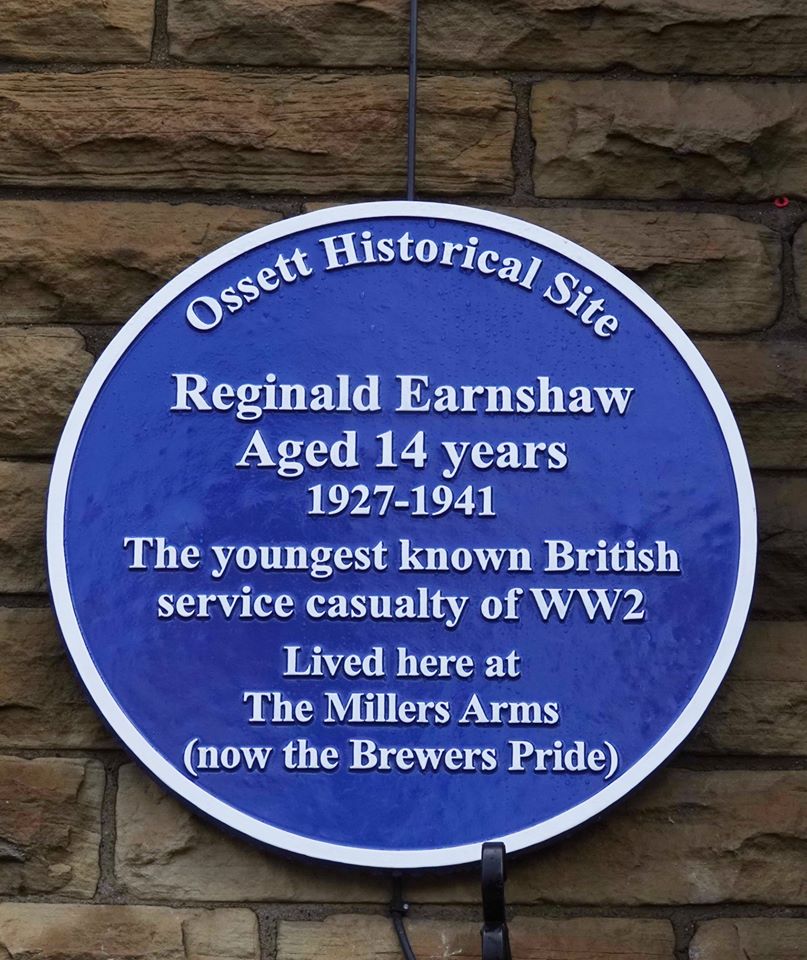
Reginald Earnshaw was 14 years and 152 days old when he lost his life aboard his merchant ship during an attack by the enemy off the East Coast of Yorkshire on 6th July 1941. Almost 69 years later on February 5th 2010, the Commonwealth War Graves Commission (CWGC) officially declared Reginald Earnshaw the youngest known British service casualty of WWII. That day would have been his 83rd birthday.
On 28th September 2019 Reginald Earnshaw, made more history when Ossett’s first Blue Plaque, bearing his name, was unveiled at his Ossett home. In November 2019 his engraved name was unveiled by Service Cadets at the Ossett Memorial in the Market Place where he joined his brothers and sisters in arms; The Ossett Fallen.
Reggie, as he was known to his family and friends, was born in Morelands Maternity Home, Dewsbury on 5th February 1927 and spent the first five years of his life with his mother at his grandfather’s home and work at The Millers Arms (aka The Brewers Pride),Healey, Ossett. His mother and stepfather moved to Dewsbury and in the late 1930’s to Edinburgh. Reggie left school at the statutory age of 14, claimed he was a year older and within weeks he had joined the Merchant Navy as a Cabin Boy; a few months later he had lost his life serving his country.
Reginald Earnshaw was remembered by the CWGC at the Tower Hill Memorial, London, erected in 1955 to commemorate the men of the Merchant Navy and Fishing Fleets who have no grave but the sea. But, unknown to the CWGC, Reggie was brought ashore that fateful day and he did have a grave; at Comely Bank Cemetery, Edinburgh. Thanks to years of persistence and determination by a Merchant Navy colleague, octogenarian , Alf Tubbs, who was aboard the same bombed ship and the efforts of several mercantile researchers , in 2008 their combined efforts and findings were officially accepted by the CWGC.
On July 6th 2009, in a ceremony 68 years to the day after Reggie’s death an official CWGC headstone was mounted on Reggie’s Edinburgh grave. Reggie’s 1941 funeral service was the very first to be held at St. David’s Episcopal Church, Pilton, Edinburgh. In May 2012 a memorial service was held there to unveil a window inscribed with a picture depicting Reggie to honour his memory as well as the memory of over 500 boys aged 16 and under who died in service with the Merchant Navy in WWII.
Reggie Earnshaw’s legacy continues and the CWGC (Scotland N&E) are now to use information about Reggie on their website and in their tours and presentations to adults and children. Reggie Earnshaw, made in Yorkshire, died in Yorkshire, buried in Scotland. He was a man before his time.
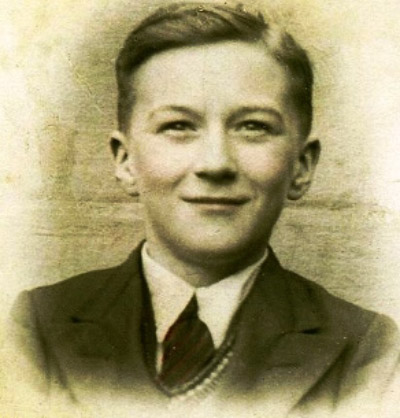
Reginald Earnshaw aged 14 years
On The Day
29th September 2019. The day of the unveiling of Ossett’s first Blue Plaque at Reggie’s first home, The Miller’s Arms Public House now known as Brewer’s Pride at Low Road, Healey, Ossett. The weather was unkind to us but approximately 100 persons attended the ceremony which was covered by ITV television and the Yorkshire Post newspaper.
Ossett Brewery and several individuals sponsored the Blue Plaque at the Brewers Pride. Reggie’s sister, Pauline Harvey, her two daughters, Louise and Frances, and a cousin Fiona Nicklin and her partner, Alan, were present at the unveiling ceremony. In recognition of Reggie’s Scottish connection and his Edinburgh burial place a Piper, David Holdsworth played in the procession.
Following brief introductions Ossett born, 98 year old John Hirst, who also joined the Merchant Navy in 1941, unveiled the Blue Plaque to honour his Merchant Navy colleague. The Royal British Legion Branch Chairman, Malcolm Patterson and Ossett Parade Marshall, Peter Waters, led the Act Of Remembrance. Bugle calls for the Last Post and Reveille were played by Charlie Welch, courtesy of the Horbury Victoria Band. Pauline Harvey laid a Merchant Navy Wreath for her brother Reggie following which the Piper played to conclude proceedings.
Thanks are due to Andrea Hartley for brining Reginald to our attention.The full biography of Reggie’s short life here;
https://ossettheritage.co.uk/ossett-in-ww2/ww2-fallen/ossett-ww2-fallen-all/reginald-earnshaw/

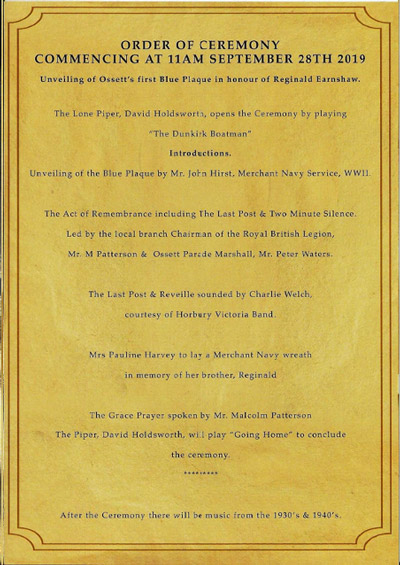
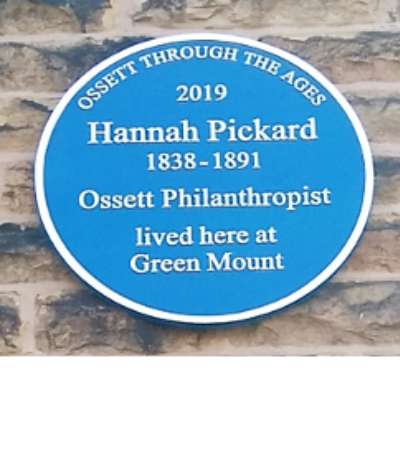
Ossett’s second Blue Plaque. The following biography was an influential part of the submission to Ossett Civic Trust for a Blue Plaque to be awarded to Hannah Pickard. Whilst the Trust voted in principle for an award, which would have been their first, the applicants subsequently decided to press on without Trust approval. Consequently the Blue Plaque bears only the applicant group’s name. The unveiling at Green Mount, the former home of the Pickard family, took place on 9th November 2019.
The Blue Plaque was erected on Green Mount, Southdale Road close to the junction with The Green.
This is the life story of an Ossett woman, Hannah Pickard, who even 128 years after her death, polarises opinion. It is time for Ossett to decide whether to honour her memory in a fitting manner; by the provision of a Blue Plaque in her name. Based on primary records this article seeks to set out for the first time the facts about Hannah Pickard. To assist the reader understand the context of the time in which she lived there is some interpretation based upon those facts. Those who have researched and written about her life find no evidence that she be not remembered in a way which other towns and cities have remembered individual kindness, selfless benefaction and philanthropy during and after life. We ask no more than this article be read, carefully considered and acted upon.
It may be that those in a position of power and influence in this matter, being devoid of self interest, conclude after objective and unbiased consideration that Hannah does not warrant recognition. In those circumstances Ossett would welcome an objective, evidence backed, written analysis of those findings. Then the final decision should be left to the people of the town she loved.
There is more modern context here too. In 1973 Ossett took away Hannah’s right to be remembered on her gravestone when it was wrecked and her body removed to an unknown mass “grave” somewhere in an unkempt and barely accessible burial ground in Gawthorpe. In 2007 the remnants of the Pickard Fountain were removed from Green Park to their new home somewhere in a private garden in distant Sharlston. This is also the time and opportunity for an Ossett redemption.
The debate about Hannah Pickard has become corrosive. Ossett needs to move on but can only do so after reasoned debate and conclusions.
 Green Mount on Southdale Road (Virtual Blue Plaque on wall)
Green Mount on Southdale Road (Virtual Blue Plaque on wall)
The Ossett Pickards Miss Hannah Pickard was a member of a prominent Ossett textile family and lived her later life at “Green Mount”, situated at the junction of Southdale Road and Ossett Green. Ossett grocer and draper, George Pickard (born 9th April 1798, a Quaker by birth) married Hannah Mitchell (born 1805) in 1824 and they had four children, two sons and two daughters: Sarah, born in 1826; David born in 1830, Andrew born in 1835 and Hannah born in 1838. All of the family were members of the adjacent Independent Congregational Church and were buried in the Church Burial Ground at nearby Dimple Well.
The Pickard family had existed in Ossett for generations and the family lived in a cottage, said to be where the substantial dwelling “Green Mount” would later be built and which was purchased by Andrew Pickard in 1876. The name Pickard has existed in Ossett for generations and is said to have its roots with those men of Picardy, France who fought with The Duke of Normandy, William The Conqueror, in the Conquest of England in late 1066. Pickards fought hard and won.
 Above: Green Mount another view whilst building work was underway (on right)
Above: Green Mount another view whilst building work was underway (on right)
George Pickard’s two sons, David and Andrew, ran successful businesses. By 1871, David was a “Cloth Manufacturing Master” employing 100 women, 20 boys and 90 men in partnership with Mark Wilby of Manor Mill, Ossett. Andrew moved to Leeds becoming a “Woollen Manufacturer”, with mill premises in Aire Street.
The family was not known for its longevity. George Pickard, the father, died after a long illness on March 7th 1852, aged 53 years. His daughter, Sarah, aged 35 years, died on May 14th 1857 of a diseased knee joint and her mother, Hannah (senior) died on April 25th 1862 aged 59 years. David, aged 52 years, died on July 6th 1882 of a fatty degeneration of the heart and his brother Andrew died on September 18th 1890 aged 54 years with heart problems and pneumonia.
Not one of Hannah’s closest family members reached the age of 60 years and she too died, on June 29th 1891, aged 52 years of a malignant disease of the pelvis. Perhaps she too expected an early death after she had witnessed the early demise of each and every one of those she loved?
Hannah Pickard’s Life What then of Hannah’s life in those circumstances at that time in history? When Hannah was born in 1838 and when she died in 1891, Queen Victoria was on the throne. Did this define Hannah? Her place was in the home. It was expected. It was demanded. Hannah Pickard was a product of her time. Hannah Pickard was a Victorian woman.
Hannah was only 13 years of age when her father George died in 1852. She was only 18 years when her ailing only sister Sarah died in 1857 and 23 years old when her mother died in 1862. In those ten years Hannah had seen death and tragedy at a time in her life when she might have expected to have been making a life of her own.
Did she forfeit that opportunity for the love of her brothers, David and Andrew, who were both single and aged only 32 and 26 years old when their mother died in 1862? They were doing what was expected of them as entrepreneurs and businessmen during the Second Industrial Revolution.
After her mother’s death in 1862 Hannah, aged 23 years, was the last surviving woman in the Pickard household. Did she give the rest of her life, almost 30 years, for her brothers, running their household as was expected of a woman of that time? If not who else would undertake that task? She became the mistress of the home of which they were all immensely proud. In that way Hannah also contributed to the success of the Pickard businesses.
There is more evidence of the selfless, self sacrificing character of this Victorian woman, Hannah Pickard. In her last nine years of life she lived at Green Mount with her brother David’s, “adopted” (illegitimate) son, George, who was only 11 years old and orphaned when his father, David, died on the 6th July 6th 1882. Perhaps, even earlier, Hannah had become a mother figure to George following his birth mother’s death in 1875 when he was barely 5 years of age.
Given the family’s history of poor health it was perhaps inevitable that Hannah would die at a relatively young age. Hannah Pickard died on June 29th 1891. She was 52 years of age.
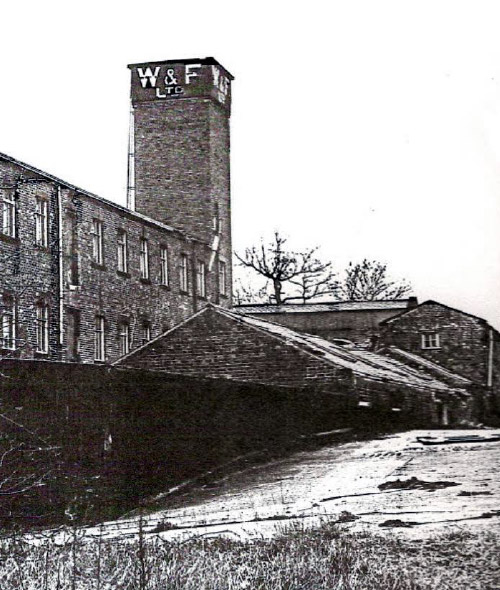
Above: Manor Mill (now demolished) was owned by partners David Pickard and Mark Wilby, both Ossett men. The mill was built in 1854 and was used for rag grinding and scribbling, employing at one stage 210 people. When David Pickard died suddenly in July 1882 aged 52, without making a will, Mark Wilby carried on the business alone and then later with David Pickard’s brother Andrew.
Inheritance Inheritance plays a major part in Hannah Pickard’s history and provides further evidence of her benevolence towards those whose lives had been less fortunate than hers. David, Andrew and Hannah herself, as surviving children, had shared equally in their mother’s estate following her death in 1862. Her will was witnessed by members of their mother’s family, Robert and James Mitchell.
Hannah Pickard lost her two brothers David and Andrew in 1882 and 1890. David died intestate and, as his heirs at law, Hannah and her surviving brother, Andrew, were each entitled to half of David’s estate. Being aware that David’s “adopted” son George had not been provided for by his father, Hannah declined her half share, assessed at £20,000 (adjusted to 2019 prices =£2.4m) which then passed in law to her brother Andrew who, in his Will, left it with his trustees for the maintenance of Green Mount and the education of David’s son, George.
When Hannah’s brother, Andrew, died in 1890, his estate was valued at £164,000 (adjusted to 2019 prices = £20.9m). His Last Will and Testament left his real estate and chattels to Hannah as his next of kin. He also made substantial bequests to many charitable causes together with sums in trust including £9,500 (adjusted to 2019 prices = £1.2m) for his uncle Robert Mitchell and his nine children or their children. Andrew left his half share of David’s estate in trust for David’s “adopted” son George and his children or, failing issue, to Robert Mitchell’s children.
Just nine months after her brother Andrew’s death, Hannah Pickard passed away at her home, Green Mount, on June 29th 1891. She left an estate worth almost £140,000 net (adjusted to 2019 prices= £17.8m). Her Will specified 56 legacies to individuals and 48 bequests to charitable organisations. In respect of her Mitchell uncle and his nine children Hannah’s Will mirrored the legacy made in her brother Andrew’s Will written shortly after David’s death in 1882. Hannah also left property to Robert Mitchell’s children; 3 cottages to his son James Mitchell and a life interest in a cottage and 2¾ acres to his married daughter, Sarah Scott.
With one exception those legacies to friends and family are too many to list here. The exception, further evidence of Hannah’s benevolence should it be needed, is the provision she made for her brother David’s “adopted” son, the orphaned George who was 20 years of age at the time of her death. Hannah was the last of his closest Pickard family. Together with her chattels Hannah left Green Mount and four acres of land to George in the hope that he would live there for the remainder of his life. That much he did, but sadly he died less than a year after Hannah, on June 10th 1892, aged 21 years. He never married.
Young George died a long, slow and debilitating death from phthisis (pulmonary tuberculosis) the virulent disease which took his mother in 1875 and which was destined to cause the victim to dwindle and waste away. It is not known how long George had suffered from the disease. Perhaps a lifetime. Hannah provided in her Will £10,000 (adjusted to 2019 prices= £1.25m) for the wife of George should he marry. Perhaps Hannah knew that he might require care for the remainder of his life. Perhaps Hannah had offered that care to George for the nine years that he lived as an orphan with Hannah until her death in June 1891 at Green Mount.

Above: The Hannah Pickard Fountain in Ossett Market Place
What then of Hannah Pickard’s benevolence to the many charitable causes?
The “Ossett Observer”, dated Saturday 11th July 1891, published a list of bequests from her Will totalling £34,950 (£4.4m adjusted to 2019 prices). Some of the charitable legacies left to institutes from further afield were:
£1000 for the maintenance of the Pickard lifeboats (bequeathed by the late Andrew Pickard);
£2100 to Ackworth Schools of The Society of Friends for a scholarship;
£1000 to The Society of Friends to provide drinking fountains and troughs for towns;
£500 to The London Home of Rest for Horses; £500 each to the Wakefield, Dewsbury and North Wales Societies for the Prevention of Cruelty to Animals;
£500 to the British and Foreign Bible Society;
£250 each to the Llandudno and the Southport Convalescent Homes; St Bartholemew’s Hospital, St Thomas’ Hospital, The Ilkley Hospital, The Harrogate Bath Hospital and Leeds Cookridge Convalescent Home;
£500 each to Brompton Cancer Hospital and The New York Hospital for Consumptives;
£500 each to The Royal Albert Asylum in Lancaster and Hull Society’s Orphan Home and School;
£1000 each to the Coatham and Redcar Convalescent Home, Doncaster Deaf and Dumb Institute, Wakefield Clayton Hospital, Dewsbury Infirmary, Leeds Hospital for Women and Children, Leeds Blind, Deaf and Dumb Institution, Leeds Victoria Home for Invalid Ladies and Leeds Unmarried Women’s Institute;
£500 each to Henshaw’s Blind Asylum in Manchester, Leeds Tradesmen’s Benevolent Society, the Yorkshire College at Leeds, the Bradford United Independent College and the Derby Railway Servants Orphanage;
£1000 for the poor of the Redcar Congregational Church;
£100 to the Leeds Trained Nurses Institution;
£50 to Liverpool Home for Nurses.
Hannah also left sums of money to Earlswood Asylum, the Commercial Travellers’ School at Pinner, the London Hospital for Diseases of the Heart and Paralysis and the Wilberforce School for the Blind at York.
Hannah Pickard’s legacy to Ossett, mainly for distribution to the poor, included £9,700 (adjusted to 2019 prices almost £1.25m) to the following:
£1000 Ossett Congregational Church (interest to be distributed among poor members of the congregation);
£1000 Ossett Primitive Methodist Chapel (for like purpose);
£1000 Ossett Common Wesleyan Chapel (for like purpose);
£1000 Ossett Common Baptist Chapel (for like purpose);
£1000 Ossett Common Primitive Methodist Chapel (for like purpose);
£2100 Ossett Grammar School (for providing scholarships);
£2100 Ossett Technical School (for like purpose);
£500 Ossett Corporation to provide a drinking fountain & water trough for cattle and dogs.
In 1893 there was a legal challenge by the Mitchell family against both Andrew’s and Hannah’s estate. William Emsley of Leeds, a solicitor, had been appointed as an Executor of both estates. The Chancery case became known as Pickard & Emsley v. Mitchell. The legalities were complex, but based upon the technical legal interpretation of what was pure and impure personalty in the Wills. The challenge, had it been successful, would have meant that the Mitchell family would benefit financially to a greater extent than hitherto they had. Certain charitable organisations would suffer an equivalent loss.
In February 1894 the judgement was declared and press coverage on February 19th 1894 included the following short summary of the Chancery Court decision:
WINDFALL FOR YORKSHIRE CHARITIES
“Mr Justice North on Saturday gave judgement in the Chancery suit arising out of the will of the late Andrew and Hannah Pickard. His lordship’s decision is that Leeds Corporation Stock is held to be pure personalty, and as such may be bequeathed to charitable institutions without interference under the statute of mortmain, the effect being that a sum of about £100,000 **is set free for division among a number of charities, of which two-thirds are in Yorkshire and the West Riding. The intention of the testator is thus carried out”
** Adjusted to 2019 prices this legal judgement in favour of Andrew and Hannah’s estates and the charities provided, in current day values, an additional £12.6m for charitable causes.
On February 20th 1894 TheYorkshire Herald in a more detailed report on the decision concluded:
“………It is satisfactory to find that the testamentary intentions of this benevolent lady will thus be carried out and that nearly the whole of her residuary estate goes to charities which she meant to benefit”.
A later challenge from the same plaintiffs was settled in May 1894 in favour of the Charities.
If there is still doubt about Hannah’s credentials what did her contemporaries have to say about her character?
In 1893 Ossett Mayor, F.L. Fothergill had this to say ” ….she was a very benevolent lady, always good to the poor and they had some proof in the fact that she bequeathed five sums of £1000 each for the relief of the poor in her native town and also two sums of £2100 each for the foundation of scholarships”.
Alderman Clay said “….a lady of very kindly and benevolent disposition…..her goodness and generosity…..”
Alderman Wilson added that “other wealthy persons in Ossett had died and their money had gone out of the town; but Miss Pickard had bequeathed large sums for the benefit of the inhabitants…..He hoped others would follow suit in leaving a portion of their wealth to the town in which it was made”.
The much respected local architect and designer of the Pickard Fountain Mr William Arthur Kendall said of Hannah “A nobler woman than Miss Pickard had never lived and had she lived longer she would have been a yet greater blessing to the poor of the borough”. He added that “he hoped that her example might do something to spur others who were quite as able but not so willing”.
Failing all else perhaps this is how we should remember Hannah Pickard. In the words of those who lived at the same time. Those who knew her best.
The Aftermath For all of her benevolence as witnessed by her actions towards others, her bequests and the words of her contemporaries the town she loved treated her poorly in 1973 and again in 2007.
The Pickard family featured above were all buried in the Ossett Green Congregational Church Burial Ground at Dimple Wells. In 1973 approximately 160 corpses, including the bodies of these Pickards, were exhumed by mechanical digger and transported by open lorry at the dead of night to Gawthorpe Zion Burial Ground. Some of the bodies that were removed were apparently “well preserved”. A large pit “a digger width across” and 9-10ft deep was the repository for the re-interred remains. No burial service was read nor other religious ceremony performed at this second burial. The exact location of the mass grave is not known.

Above: Hannah Pickard Fountain. Picture courtesy of Andrea Hartley.
Hannah Pickard’s Will required her Executors to erect a drinking fountain and water trough in the Market Place or in some other suitable location at a cost of about £500 (adjusted to 2019 prices ; £63,000) to be presented to the Corporation of Ossett as a memorial of the 1890 Incorporation of Ossett and the donor. It was erected in the Market Place in 1893 and began to be dismantled in 1948 to be removed entirely in 1956. After several years of storage, what remained of the memorial was relocated in Green Park shortly before 1964. Having suffered at the hands of vandals, the remains of the memorial was finally removed on the authority of Wakefield Metropolitan District Council in 2007”.
References:
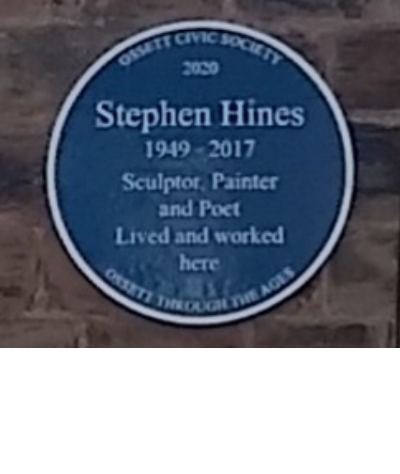
Stephen Hines was an inspirational teacher and an internationally – renowned sculptor. He exhibited at the Royal Academy, Leeds Playhouse, Wakefield Cathedral, Christie’s and Covent Garden in London, Scone Palace in Scotland, and at Expo 88 in Brisbane, Australia.
In 1983 he was commissioned by the Vatican and a year later, he was selected to represent Britain at an international symposium on sculpture in Carrara, following which he attended a civic reception at Leeds and was acknowledged by Buckingham Palace and Downing Street for his achievement. He was also recognised in Who’s Who of Art.
Stephen Hines’ Blue Plaque was erected on 16th January 2021 during the 2020-2021 pandemic.
“Stephen Hines was an inspirational teacher in his native Yorkshire and an internationally-renowned sculptor whose commissions included a statue of the Madonna and Child for the Vatican. Entirely self-taught, his artistic talent had been spotted by the nuns who taught him at St Joseph’s School in the Leeds district of Hunslet and inspired him to hitchhike to Italy, where he learnt the “old ways” alongside the masons in the marble quarries of Carrara.
He had left school at fifteen to become a French polisher, and later spent three months in the 5th Royal Tank Regiment, before deciding the military was not for him. Instead, he gained qualifications at night school and attended Keswick Hall College of Education in Norwich, where he met his wife, Margaret. They married in 1974 and he became a schoolteacher, eventually settling in Ossett, where he maintained a home studio.
His commissions included hundreds of sculptures in stone and marble, as well as sandblasts. His piece Leodis, produced for the opening of the St. John’s Centre in Leeds, depicted the history of the city. More recently he completed a memorial called Victims of War, to the people of Leeds who were hit during the Second World War.
He exhibited at the Royal Academy, Leeds Playhouse, Wakefield Cathedral, Christie’s and Covent Garden in London, Scone Palace in Scotland, and at Expo 88 in Brisbane, Australia.
His biggest assignment was the 12ft Millennium of the West which portrays a mixture of carved characters set amidst a pageant of events which shaped modern history. Sited off Thorpe Lane in Tingley, near Morley, it was originally designed to be the centrepiece of a hotel and leisure complex. But, he lamented, it never got off the ground, and he was never paid. He carved it from a block of Morley Bluestone, and noted that had Michelangelo been a Yorkshireman, he would have used it, too.
His Vatican commission came in 1983, and a year later, he was selected to represent Britain at an international symposium on sculpture in Carrara, following which he attended a civic reception at Leeds and was acknowledged by Buckingham Palace and Downing Street for his achievement. He was also recognised in Who’s Who of Art.
After two earlier strokes, he sculpted the 7ft Tree of Life for Pinderfields Hospital in Wakefield and a piece for Dewsbury and District Hospital. They were, he said, “payback” for the care he received there.Tree of Life, which sits within the grounds of Pinderfields, has an organ donation theme which, he hoped, would encourage families to think about using a death to give others the same second chance of life that he had had.
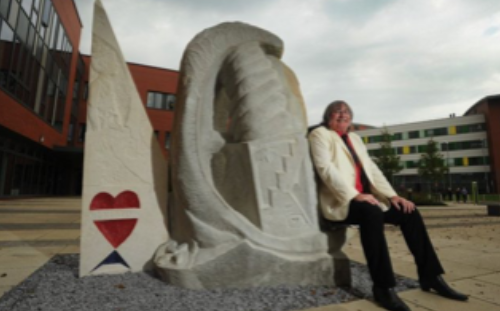
Stephen Hines with his sculpture ‘The Tree of Life’ outside Pinderfields Hospital.
In parallel with his art work, Mr Hines taught at several schools in south Leeds before moving to Morley High School. He spent 14 years teaching English and later running the Learning Support Centre.
He was also was renowned for his love of music and formed a rock and roll band called The Beanz, made up of pupils who remained friends. He produced several charity shows which raised thousands of pounds for the school, and when the old hall burnt down he sculpted Phoenix, which stands in the new foyer.
A keen rugby union player in his day, having played and coached at Morley, he also donated a statue to the memory of John Howe, who had died during a match there”.
Reference.
Obituary Yorkshire Evening Post 15th December 2017.
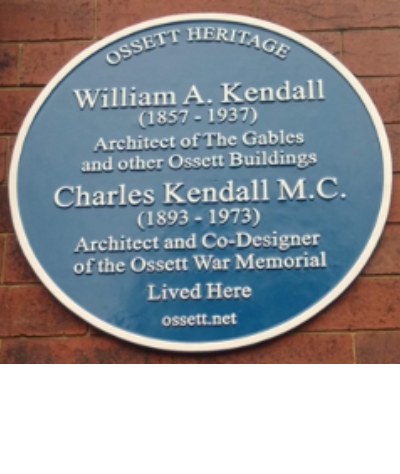
At 11a.m. on Saturday, 21st August 2021 at The Gables, Station Road, Ossett unveiled its fourth Blue Plaque. This was in honour of uncle and nephew William Arthur Kendall (1857-1937) & Lieutenant Charles Kendall M.C.(1893-1973), of The Gables.
Due to Covid 19 the unveiling ceremony was restricted to an invited audience and included the local councillors and representatives of the Ossett Historical Society. Approximately twenty people attended the unveiling.
In the face of great adversity and personal misfortune, William Arthur Kendall, Architect of this town, used his vision and architectural skills to change and enhance a significant part of Ossett’s late 19th century streetscape; much of which still survives. For all his remarkable achievements William Arthur Kendall is relatively unknown for his contribution to the town.
Courtesy of Andrew Daniel the Blue Plaque was mounted on the wall of William Arthur’s former home at The Gables on Station Road a grand late Victorian terrace of six dwellings designed, built and owned by William Arthur Kendall in 1897. Number 1, The Gables (latterly 115 Station Road) was his home for the second half of his life between 1900 & 1937.
When next you visit Ossett town centre, look up and see what William Arthur Kendall made for the town in which he lived for 75 of his 80 years.
The Conservative Club on New Street (opened 1881) Now CJ Moody’s
The Temperance Hall Illingworth Street (opened 1888) Spring Church
The Mechanics’ Institute & Technical School Station Road (opened 1890 latterly Ossett Library)
The Pickard Fountain (opening ceremony 1893)
The Liberal Club (opened 1893) Formerly the British Railway Staff Association and latterly The Railway Club.
The Post Office and Chemist’s shop junction of Station Road &Prospect Road (opened 1894 & known as Cussons) Latterly the Yorkshire Bank, now Kerr’s Angling Centre
The Infectious Diseases Hospital Storrs Hill.(opened 1894 )Now Dwellings
The Gables, Station Road ( 1899-1900). Still dwellings
Southdale Council School Southdale Road (opened 1908). Still a School
His nephew and, to large extent, his ward, Lieutenant Charles Kendall M.C., (1893-1973) is also honoured on the Blue Plaque. Charles was one of only two Ossett WWI servicemen known to have been awarded the Military Cross for exemplary gallantry in the face of the enemy. He too became an architect and co-designed the Ossett War Memorial after he returned home following WWI; perhaps the only soldier who served in WWI to design a War Memorial to remember those who fell in that conflict. How many towns can say that a war hero designed their War Memorial?
What of William Arthur’s adversities in life? By 1880, aged 23 years, he had established his architectural business on Bank Street and gained his first major commission, the Conservative Club, New Street which opened in 1881. His next Ossett major commissions had to wait for seven more years.
Sadly his mother died in February 1880, aged 55 years and his brother, aged 21years, died six weeks later. Both were buried at Holy Trinity Church Ossett. In May 1881 his uncle, who lived in Horbury, was imprisoned for embezzlement and his father, the head master of Ossett Free (Grammar) School, was wanted by the police for the same offence.
William Arthur Kendall was one of six Kendall children whose lives had been torn apart in 1880/81 by death and abandonment; he was left to care and provide for those of his siblings who had yet to reach working age. His misfortune was not complete for in early 1888 his 33year old sister died leaving four children. William Arthur married in late 1888 only to lose his beloved wife ten years later. It was about this time that his youngest sister, by then the mother of three, appears to have been abandoned by her husband. William Arthur Kendall stepped in to provide them with a home. This was The Gables.
He overcame all of that. His determination and vision built a reputation for designing the finest of buildings which gave Ossett a “more ornamental style of architecture”. It took the town to a new level of splendour and sophistication which was unimaginable just 10 years earlier. Moreover all but one of those buildings exists today. This is the Kendall family legacy. This is where they will be remembered.

The Gables in 1907 with Tram & Ossett Town Hall in background. Courtesy Andrea Hartley
We thank those sponsors who made contributions toward the cost of the Blue Plaque. Our gratitude too to the present owners and custodians of The Gables, 115 Station Road, Emily & Dean Johnson, and their children, for their patience and understanding over the last fifteen covid ridden months. William Arthur Kendall would be proud and pleased to know that his former home is in safe hands.
Thanks too to Marie Williams and her mother, Gladys May Gara, 93 years young, who now live in Victoria, Australia. The family were once owners of The Gables house next door to William Arthur’s home and they have enthusiastically supported us with tales of their lives at The Gables.
Full biographies by Alan Howe (November 2015 & January 2021) can be seen at these links;
https://ossettheritage.co.uk/ossett-in-ww1/ossett-ww1-medal-winners/charles-kendall-hanson/
https://ossettheritage.co.uk/local-history/people/people/